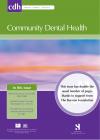Community Dental Health

- Cover Date:
- March 2011
- Print ISSN:
- 0265 539X
- Vol:
- 28
- Issue:
- 1
The success of fissure sealants placed by dentists and dental care professionals
Objective: To obtain preliminary data on the effectiveness of fissure sealants placed by dentists and dental care professionals (DCPs). Research design: Case-note review of fissure sealants provided for paediatric patients within primary dental services in South Yorkshire. Participants: Records were retrieved for 1,100 fissure sealants, placed on first and second permanent molars of 312 children by 25 participating dentists and 25 DCPs during 2001-2003. Main outcome measures: Independent variables included operator details and patient-related factors including: caries experience at baseline, age, gender, and socio-economic status. The outcome variables were sealant retention and progression to caries at three years. Bivariate analyses were used to explore the role of potential factors associated with the success of fissure sealant survival. Kaplan-Meier survival analysis and Cox’s regression models were used to estimate the probability of sealant success for both operator groups. Results: Retention rates at three years for fissure sealants placed by dentists and DCPs were 62.4 % (SD=22.1) and 58.1% (SD=21.5) respectively. After three years, 87.1% (SD=9.8) and 84.2% (SD=11.6) of teeth sealed by dentists and DCPs remained sound. Exploratory analysis found no significant difference in sealant retention or caries transformation rates according to operator type. Conclusions: On the basis of these preliminary findings, delegation of fissure sealants to DCPs would seem to be justified in view of the comparable sealant success rates achieved by dentists and DCPs. These data can now be used to inform future randomised controlled trials on the effectiveness of fissure sealants by different operator groups.
Key words:, Caries prevention, dental care professional, fissure sealant.
- Article Price
- £15.00
- Institution Article Price
- £
- Page Start
- 99
- Page End
- 103
- Authors
- F. Nilchian, H.D. Rodd, P.G. Robinson
Articles from this issue
- Title
- Pg. Start
- Pg. End
- The caries experience of 5 year-old children in Scotland, Wales and England in 2007-2008 and the impact of consent arrangements. Reports of co-ordinated surveys using BASCD criteria
- 5
- 11
- The dilemma of selecting suitable proximal carious lesions in primary molars for restoration using ART technique.
- 12
- 16
- Using laser fluorescence (DIAGNOdent) in surveys for the detection of noncavitated occlusal dentine caries
- 17
- 21
- The prevalence of and risk factors for non-carious cervical lesions in adults in Hubei Province, China
- 22
- 28
- Health-related lifestyle behaviours, socio-demographic characteristics and use of dental health services in Greek adults.
- 47
- 52
- Periodontal health and treatment needs among hospitalized chronic psychiatric patients in Istanbul, Turkey
- 69
- 74
- Comparison of the COHIP and OHIP- 14 as measures of the oral health-related quality of life of adolescents
- 82
- 88
- Assessment and comparison of periodontal status among young smokers and nonsmokers of Bangalore, India - a cross sectional study.
- 89
- 94
- Smoking and drinking habits and attitudes to smoking cessation counselling among Tanzanian dental students
- 95
- 98
- Traumatic dental injuries to primary incisors and the terminal or occlusal plane relationship in Indian preschool children
- 104
- 106
- Teaching dental public health to undergraduates using community profiles and patient case studies
- 116
- 120
